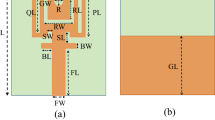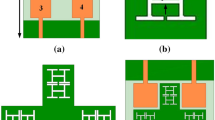Abstract
In this paper a multiband modified ‘W’ shaped, Multiple input multiple output (MIMO) antenna with a metamaterial inspired isolator for enhanced isolation is proposed for 5G application. The two-element MIMO antenna comprises of a closely placed (edge to edge gap of 0.117λo, λo = highest operating wavelength) antenna elements that covers both sub-6 GHz (3.42–4.25 GHz) and millimeter wave (mmWave) range bands (24.8–26.5 GHz) of 5G with bandwidth of 821 MHz and 1630 MHz. The MIMO antenna also covers bands C (7.44–7.92 GHz), X (9.9–10.49 GHz), Ku (12.02–13.39 GHz & 15.92–17.492 GHz), K (19.49–22.42 GHz), partially. The isolation level in all resonating bands remain near to the acceptable value of (|S12|> −15 dB) however a very significant mutual coupling effect is observed in sub-6 GHz range (|S12|= −11.92 dB at 3.94 GHz). To improve the isolation in sub-6 GHz band, a metamaterial inspired isolator comprising of Double negative (DNG) unit cells is uniquely placed along the side of the closely positioned antenna elements. Simulated results indicate that isolation level improves to (|S12|= −16.1 dB at 3.94 GHz) after placing the DNG metamaterial based isolator. The antenna performance parameters such as gain, return loss, bandwidth, Envelope correlation coefficient (ECC), Diversity gain (DG) and radiation efficiency are not affected by placement of isolator. The metamaterial equipped MIMO antenna (Meta–MIMO antenna) has a compact structure of 70 × 40 × 0.8 mm3, with a high isolation in all bands (|S12|> −16 dB), peak gain of 7.8dBi, low ECC (< 0.05), high diversity gain (9.98 dB) and efficiency (≈91.38%). Further the proposed Meta-MIMO antenna performance for practical applications is investigated by connecting to different sizes of ground plane, the results indicate that the isolation levels and efficiency do not deteriorate.
















Similar content being viewed by others
Data Availability
The data can be made available with appropriate request to the corresponding author.
References
GSMA white paper (2021). 5G Spectrum from http://www.coleago.com/wp-content/uploads/2020/12/Demand-for-IMT-spectrum-Coleago-14-Dec-2020.pdf.
Saxena, S., Kanaujia, B. K., Dwari, S., et al. (2018). MIMO antenna with built-in circular shaped isolator for sub-6 GHz 5G applications. Electronic Letters, 54, 478–480.
Jing, Y.-D., Yao, J., Sun, D., et al. (2018). Ten-element MIMO antenna for 5G terminals. Microwave and Optical Technology Letters, 60(3), 759–765.
Andrews, J. G., Buzzi, S., Choi, W., et al. (2014). What Will 5G Be? IEEE Journal on Selected Areas in Communications, 32(6), 1065–1082.
Kumar G., Ray, K.P. (2003). Broadband Microstrip Antennas, Artech House, MA.
Hussain, R., Khan, M. U., & Sharawi, M. S. (2018). An integrated dual MIMO antenna system with dual-function GND-plane frequency-agile antenna. IEEE Antennas and Wireless Propagation Letters, 17(1), 142–145. https://doi.org/10.1109/LAWP.2017.2778182
Jehangir, S. S., & Sharawi, M. S. (2017). A miniaturized UWB biplanar yagi-Like MIMO antenna system. IEEE Antennas and Wireless Propagation Letters, 16, 2320–2323. https://doi.org/10.1109/LAWP.2017.2716963
Babu, K. V., & Anuradha, B. (2021). Design of UWB MIMO antenna to reduce the mutual coupling using defected ground structure. Wireless Personal Communication, 118, 3469–3484. https://doi.org/10.1007/s11277-021-08189-6
Niu, Z., Zhang, H., Chen, Q., et al. (2019). Isolation enhancement for closely spaced E-plane patch antenna array using defect ground structure and metal-vias. IEEE Access, 7, 119375–119383. https://doi.org/10.1109/ACCESS.2019.2937385
Jamal, M. Y., Li, M., & Yeung, K. L. (2020). isolation enhancement of closely packed dual circularly polarized MIMO antenna using hybrid technique. IEEE Access, 8, 11241–11247. https://doi.org/10.1109/ACCESS.2020.2964902
Ramesh, R., & Kommuri, U. K. (2020). Isolation enhancement for dual-band MIMO antenna system using multiple slots loading technique. International Journal of Communication System. https://doi.org/10.1002/dac.4470
Ghosh, C. K., Pratap, M., Kumar, R., et al. (2020). Mutual coupling reduction of microstrip MIMO antenna using microstrip resonator. Wireless Personal Communications, 112, 2047–2056. https://doi.org/10.1007/s11277-020-07138-z
Tang, M., et al. (2017). Mutual coupling reduction using meta-structures for wideband, dual-polarized, and high-density patch arrays. IEEE Transactions on Antennas and Propagation, 65(8), 3986–3998. https://doi.org/10.1109/TAP.2017.2710214
Sarkar, D., & Srivastava, K. V. (2017). Compact four-element SRR-loaded dual-band MIMO antenna for WLAN/WiMAX/WiFi/4G-LTE and 5G applications. Electronics Letters, 53(25), 1623–1624.
Roy, S., & Chakraborty, U. (2020). Mutual coupling reduction in a multi-band MIMO antenna using meta-inspired decoupling network. Wireless Personal Communications, 114, 3231–3246. https://doi.org/10.1007/s11277-020-07526-5
Alibakhshikenari, M., Khalily, M., Virdee, B. S., et al. (2019). Mutual coupling suppression between two closely placed microstrip patches using EM-Bandgap metamaterial fractal loading. IEEE Access, 7, 23606–23614. https://doi.org/10.1109/ACCESS.2019.2899326
Liu, F., Guo, J., Zhao, L., et al. (2020). Dual-band metasurface-based decoupling method for two closely packed dual-band antennas. IEEE Transactions on Antennas and Propagation, 68(1), 552–557. https://doi.org/10.1109/TAP.2019.294031
Guo, J., Liu, F., Zhao, L., et al. (2019). Meta-surface antenna array decoupling designs for two linear polarized antennas coupled in H-plane and E-plane. IEEE Access, 7, 100442–100452. https://doi.org/10.1109/ACCESS.2019.2930687
Feng, B., Chung, K. L., Lai, J., & Zeng, O. (2019). A conformal magneto- electric dipole antenna with wide H-plane and band-notch radiation characteristics for sub-6-GHz 5G base-station. IEEE Access, 7, 17469–17479. https://doi.org/10.1109/ACCESS.2019.2896356
Jiang, T., Jiao, T., & Li, Y. (2018). A low mutual coupling MIMO antenna using periodic multi-layered electromagnetic band gap structures. Applied Computational Electronics Society Journal, 33(3), 305–311.
Liu, Y., Yang, X., Jia, Y., & Guo, Y. J. (2019). A low correlation and mutual coupling MIMO antenna. IEEE Access, 7, 127384–127392. https://doi.org/10.1109/ACCESS.2019.2939270
Tan, X., Wang, W., Wu, Y., et al. (2019). Enhancing isolation in dual-band meander-line multiple antenna by employing split EBG structure. IEEE Transactions on Antennas and Propagation, 67(4), 2769–2774. https://doi.org/10.1109/TAP.2019.2897489
Wang, M., Xu, B., Li, Y., et al. (2019). Multiband multiple-input multiple-output antenna with high isolation for future 5G smartphone applications. International Journal of RF and Microwave Computer Aided Engineering. https://doi.org/10.1002/mmce.21758
Li, Y., Sim, C.-Y., Luo, Y., et al. (2019). Metal-frame-integrated eight-element multiple-input multiple-output antenna array in the long-term evolution bands 41/42/43 for fifth generation smartphones. International Journal of RF and Microwave Computer Aided Engineering. https://doi.org/10.1002/mmce.21495
Hu, W., et al. (2019). Dual-band ten-element MIMO array based on dual-mode IFAs for 5G terminal applications. IEEE Access, 7, 178476–178485. https://doi.org/10.1109/ACCESS.2019.2958745
Serghiou, D., Khalily, M., Singh, V., et al. (2020). Sub-6 GHz dual-band 8 × 8 MIMO antenna for 5G smartphones. IEEE Antennas and Wireless Propagation Letters, 19(9), 1546–1550. https://doi.org/10.1109/LAWP.2020.3008962
Biswas, A., & Gupta, V. R. (2020). Design and development of low profile MIMO antenna for 5G new radio smartphone applications. Wireless Personal Communications. https://doi.org/10.1007/s11277-019-06949-z
Xu, Z., & Deng, C. (2020). High-isolated MIMO antenna design based on pattern diversity for 5G mobile terminals. IEEE Antennas and Wireless Propagation Letters, 19(3), 467–471. https://doi.org/10.1109/LAWP.2020.2966734
Abbas, E. A., Ikram, M., Mobashsher, A. T., et al. (2019). MIMO antenna system for multi-band millimeter-wave 5G and wideband 4G mobile communications. IEEE Access, 7, 181916–181923. https://doi.org/10.1109/ACCESS.2019.2958897
Wong, K., Chang, H., Chen, J., et al. (2020). Three wideband monopolar patch antennas in a Y-shape structure for 5G multi-input–multi-output access points. IEEE Antennas and Wireless Propagation Letters, 19(3), 393–397. https://doi.org/10.1109/LAWP.2020.2967354
Zhao, A., & Ren, Z. (2019). Wideband MIMO antenna systems based on coupled-loop antenna for 5G N77/N78/N79 applications in mobile terminals. IEEE Access, 7, 93761–93771. https://doi.org/10.1109/ACCESS.2019.2913466
Ren, Z., Zhao, A., & Wu, S. (2019). MIMO antenna with compact decoupled antenna pairs for 5G mobile terminals. IEEE Antennas and Wireless Propagation Letters, 18(7), 1367–1371. https://doi.org/10.1109/LAWP.2019.2916738
Ikram, M., Nguyen-Trong, N., & Abbosh, A. (2020). Hybrid antenna using open-ended slot for integrated 4G/5G mobile application. IEEE Antennas and Wireless Propagation Letters, 19(4), 710–714. https://doi.org/10.1109/LAWP.2020.2978181
Rusni, I. M., Ismail, A., Alhawari, A. R. H., et al. (2014). An aligned-gap and centered-gap rectangular multiple split ring resonator for dielectric sensing applications. Sensors, 2014(14), 13134–13148.
Balanis, C.A. (2005). Antenna Theory Analysis and Design. John Wiley & Sons, New York.
Nadeem, I., & Choi, D. Y. (2019). Study on mutual coupling reduction technique for MIMO antennas. IEEE Access. https://doi.org/10.1109/ACCESS.2018.2885558
Krzysztofik,W.J., Cao,T.N. (2018). Metamaterials in Application to Improve Antenna parameters. In Joseph Canet-Ferrer (Eds.), Metamaterials and Metasurfaces, IntechOpen, https://doi.org/10.5772/intechopen.80636.
Dong, Y., & Itoh, T. (2012). Metamaterial-based antenna. Proceedings of the IEEE, 100(7), 2271–2285. https://doi.org/10.1109/JPROC.2012.2187631
Sharawi, M. S. (2013). Printed multi-band MIMO antenna systems and their performance metrics. IEEE Antennas Propagation Magazine, 55(5), 218–232.
Sharawi, M., Hassan, A., & Khan, M. (2017). Correlation coefficient calculations for MIMO antenna systems: a comparative study. International Journal of Microwave and Wireless Technologies, 9(10), 1991–2004. https://doi.org/10.1017/S1759078717000903
Caloz, C., & Itoh, T. (2006). Electromagnetic Metamaterials: Transmission Line Theory and Microwave Applications, The Engineering Approach. John Wiley & Sons.
Author information
Authors and Affiliations
Corresponding author
Ethics declarations
Conflicts of interest
The authors declare that they have no conflict of interest.
Consent for publication
Yes.
Additional information
Publisher's Note
Springer Nature remains neutral with regard to jurisdictional claims in published maps and institutional affiliations.
Appendix A
Appendix A
According to Nicholson Ross weir method, the dielectric parameters i.e. permittivity, permeability and refractive index of a metamaterial can be expresses in terms of its dielectric thickness (d), reflection(S11) and transmission coefficients (S21) as per following equations [41]:
where,
Rights and permissions
About this article
Cite this article
Sharma, R., Khanna, R. & Geetanjali Compact Sub-6 GHz and mmWave 5G Wideband 2 × 1 MIMO Antenna with High Isolation Using Parasitically Placed Double Negative (DNG) Isolator. Wireless Pers Commun 122, 2839–2857 (2022). https://doi.org/10.1007/s11277-021-09032-8
Accepted:
Published:
Issue Date:
DOI: https://doi.org/10.1007/s11277-021-09032-8




